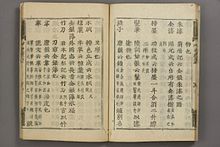Wamyō Ruijushō
This article needs additional citations for verification. (February 2016) |

The Wamyō ruijushō or Wamyō ruijūshō (
The Wamyō ruijushō is the oldest extant Japanese dictionary organized into semantic headings, analogous to a Western language thesaurus. This ancient lexicographical collation system was developed in Chinese dictionaries like the Erya, Xiao Erya, and Shiming. The Wamyōshō categorizes kanji vocabulary, primarily nouns, into main headings (bu
Each dictionary entry gives the Chinese character, sources cited, Chinese pronunciations (with either a homonym or fanqie spelling), definitions, and corresponding Japanese readings (in the ancient Man'yōgana system using kanji to represent Japanese pronunciation). It cites over 290 sources, both Chinese (for example, the Shuowen Jiezi) and Japanese (the Man'yōshū).
The Wamyō ruijushō, survives in both a 10-volume edition (
| Rōmaji | Kanji | Translation | Subjects | |
|---|---|---|---|---|
| 1 | Tenchi | Universe | constellations, weather, gods, earth, topography | |
| 2 | Jinrin | Humans | gender, kinship, family, marriage | |
| 3 | Keitai | Body | body parts, sense organs, internal organs | |
| 4 | Shippei | Sickness | diseases, wounds | |
| 5 | Jutsugei | Arts | martial arts, fine arts, skills | |
| 6 | Kyosho | Architecture | houses, walls, doors, roads | |
| 7 | Sensha | Vehicles | boats, carts, carriages | |
| 8 | Chinpō | Treasures | precious metals, jewels | |
| 9 | Fuhaku | Textiles | embroidery, silks, woven fabrics | |
| 10 | Shōzoku | Clothing | hats, clothes, belts, shoes | |
| 11 | Inshoku | Foods and Drinks | liquors, beverages, cooked grains, fruits, meats | |
| 12 | Kibei | Utensils | objects of metal, lacquer, wood, tile, and bamboo | |
| 13 | Tōka | Illumination | lamps, lights, lighting | |
| 14 | Chōdo | Things and Supplies | implements, tools, weapons, utensils, furnishings | |
| 15 | Uzoku | Birds | birds, feathers, ornithology | |
| 16 | Mōgun | Wild Animals | wild animals, body parts | |
| 17 | Gyūba | Domestic Animals | cattle, horses, sheep, body parts, diseases | |
| 18 | Ryōgo | Aquatic animals | dragons, fish, reptiles, amphibians | |
| 19 | Kibai | Shellfishes | turtles, shellfish | |
| 20 | Chūchi | Miscellaneous Animals | insects, worms, small reptiles | |
| 21 | Tōkoku | Grains | rices, cereals | |
| 22 | Saiso | Vegetables | tubers, seaweeds, edible plants | |
| 23 | Kayu | Fruits | fruits, melons | |
| 24 | Sōmoku | Plants | grasses, mosses, vines, flowers, trees |
The broadly inclusive Wamyō ruijushō dictionary was an antecedent for Japanese encyclopedias. In the present day, it provides linguists and historians with an invaluable record of the Japanese language over a thousand years ago,[2] more specifically the linguistics of the 10th century and Heian Period.[3]
References[edit]
- ^ "Kariya Ekisai". Oxford Reference. Retrieved 2021-03-23.
- ^ For more details, see Bailey, Don Clifford. (1960). "Early Japanese Lexicography". Monumenta Nipponica 16:1-52. pp. 4–6, 18–9. in English, and Mori Shiten
林 史 典 . (1996). "和名 類聚 抄 (Wamyō ruijushō)." In Nihon jisho jiten日本 辞書 辞典 (The Encyclopedia of Dictionaries Published in Japan), Okimori Takuya沖 森 卓也 , et al., eds., pp. 287–288. Tokyo: Ōfū. ISBN 4-273-02890-5 in Japanese. - ^ "Wamyō Ruijushō • . A History . . of Japan .
日本 歴史 ". . A History . . of Japan .日本 歴史 . Retrieved 2021-12-06.
Further reading[edit]
- Minamoto, Shitagō (1968) [c. 934]. Shohon Shūsei Wamyō Ruijushō: Honbunhen. Kyōto: Rinsen. ISBN 4-653-00507-9.
- Minamoto, Shitagō (1968). Shohon Shūsei Wamyō Ruijushō: Sakuinhen. Kyōto: Rinsen. ISBN 4-653-00509-5.
- Minamoto, Shitagō (1966) [c. 934]. Shohon Shūsei Wamyō Ruijushō: Gaihen. Kyōto: Rinsen. ISBN 4-653-00508-7.
External links[edit]
倭名 類 聚鈔 Archived 2006-11-12 at the Wayback Machine, Waseda University Library online Wamyō ruijushō (in Japanese)- Manuscript scans at Waseda University Library: 1617, 1667, 1667, 1688, 17th century, 17th century
